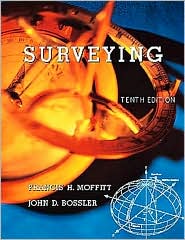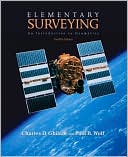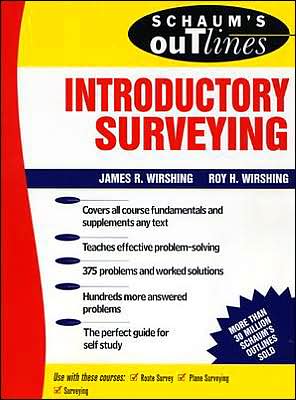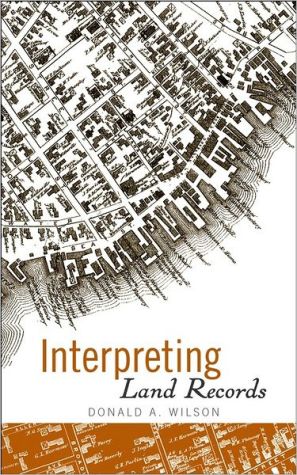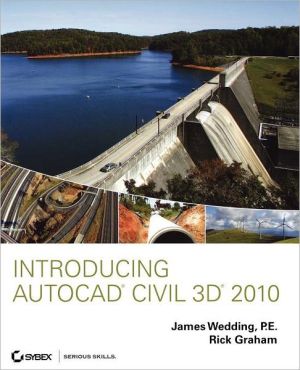Surveying
The practice of modern surveying is undergoing rapid change due to the availability of electronically controlled instruments, the widespread adoption of the Global Positioning System (GPS), and the proliferation of various geographic Land Information Systems (GIS/LIS). Nevertheless, the principles underlying these new technologies remain constant. In the tenth edition of this benchmark text, Frank Moffitt and John Bossler strike the appropriate balance between teaching students the...
Search in google:
The practice of modern surveying is undergoing rapid change due to the availability of electronically controlled instruments, the widespread adoption of the Global Positioning System (GPS), and the proliferation of various geographic Land Information Systems (GIS/LIS). Nevertheless, the principles underlying these new technologies remain constant. In the tenth edition of this benchmark text, Frank Moffitt and John Bossler strike the appropriate balance between teaching students the fundamental principles of surveying and bringing them up to date on the technological advances that are changing the field.The tenth edition of this classic work completely modernizes much of the notation, form, and substance of the original. By removing much of the dated information, the authors have been able to add entire new chapters on GPS and GIS. Throughout the text, emphasis is placed on NAD 83 over NAD 27 as the new datum is being utilized more frequently.Readers familiar with previous editions of this textbook will still recognize its clear, yet rigorous explanation of topics. No shortcuts are taken in the presentation of material from the time a concept is introduced through its exploration in worked examples. The book¿s tradition of covering both plane and geodetic surveying has been preserved, which makes it the most comprehensive introductory text on surveying in the market.
Surveying is essentially the science of measurement of the spatial positions of the features on or near the surface of the earth. The practice of surveying is changing rapidly because of the availability of electronically controlled instruments, automatic capture and rapid transfer of field measurements, widespread adoption of the Global Positioning system (GPS), and the proliferation of various geographic Land Information Systems (GIS/LIS). Nevertheless, the principles underlying the new technology remain fairly constant. For example, the basic equations and computing techniques presented in this book are used to develop the computer programs employed by the practicing surveyor. Software is available for practically any situation encountered by the surveyor, including coordinate geometry, traverse calculations, adjustment computations, directions from astronomical observations, road design and layout, earthwork calculations, and stake-out data.\ The authors have attempted to present the material underlying these forgoing advances in such a way that the student can learn the principles of surveying by self-study. References at the ends of the chapters are intended to expand the knowledge acquired throughout study of the basic principles found in the book.\ Several major revisions have been made since the previous edition. Moreover, every chapter has been brought up to date and changed , although some only slightly. The information on Inertial Surveying has been dropped completely. Chapter 10 is devoted to GPS, thus separating traditional control surveying from this expanding technology and providing a simple but comprehensive explanation of GPS. Emphasis is placed on the NAD 83 as contrasted with NAD 27, as the redefinitions of the control networks in North America are now complete and the new datum is being utilized at a rapidly growing rate. In Chapter 11 we provide a computer program (TRANSFOR) to compute state plane coordinates. The examples provided with the program are the same as those given in the text.\ Chapter 20 on Geographic Information Systems has been added, along with a problem set and a compete and an extensive bibliography. Appendix A has been shortened considerably be removing the sections no the adjustment of triangulation.\ We have worked hard to make this book readable and easy to understand, while at the same time presenting current material that will be valuable to the modern surveyor.\ \ ACSM Bulletin, published by the American Congress on Surveying and Mapping, 5410 Grosvenor Lane, Bethesda, MD 20814, (301) 493-0200.\ Geodetical Information Magazine, published by the Geodetical Information and Trading Center, G.I.T.C.b.v., Villa Novalaan 14, 8531 HS Lemmer, The Netherlands, +31(0)-5416-1854.\ GeoInfo Systems, published by the Advanstar Communications, 859 Willamette Street, Eugene, OR 97400, (541) 343-1200.\ GIS World, published by GIS World Inc., 155 E. Boardwalk Drive, Suite 250, Fort Collins CO 80525, (970) 223-4848.\ GPS World, published by GPS World Corporation, 859 Willamette Street, Eugene OR 97440, (503) 343-1200\ Point of Beginning, better known as P.O.B., Published by Business News Publishing Company, P.O. Box 7069, 755 West Big Beaver Road, Suite 1000, Troy, MI 48007, (810) 362-3700\ Professional Surveyor, published by Professional Surveyors Publishing Company, Inc. Suite 501, 2300 Ninth Street South, Arlington, VA 22204-2320, (703) 892-0733.\ Surveying and Land Information Systems, published by the American Congress on Surveying and Mapping.\ Technical Papers of the Annual and Fall conventions of the American Congress on Surveying and Mapping.\ \ The majority of the articles listed in the bibliographies are take from the publications listed above.
PrefaceCh. 1Introduction1Ch. 2Measurement of Horizontal Distances15Ch. 3Leveling61Ch. 4The Measurement of Angles128Ch. 5Random Errors177Ch. 6Field Operations with the Transit or Theodolite213Ch. 7Direction of a Line230Ch. 8Traverse Surveys and Computations241Ch. 9Horizontal Control Networks317Ch. 10The Global Positioning System349Ch. 11State Plane Coordinate and Universal Transverse Mercator Systems369Ch. 12Practical Astronomy432Ch. 13Horizontal and Vertical Curves466Ch. 14Tacheometry506Ch. 15Topographic Surveys528Ch. 16Photogrammetry550Ch. 17Earthwork590Ch. 18United States Public Land Surveys627Ch. 19Municipal and Subdivision Surveys655Ch. 20Geographic Information Systems672App. AAdjustment of Elementary Surveying Measurements by the Method of Least Squares688App. BThe Adjustment of Instruments719App. CTables726Index731
